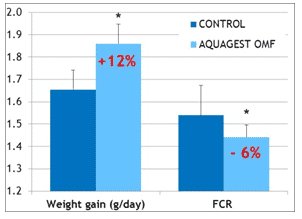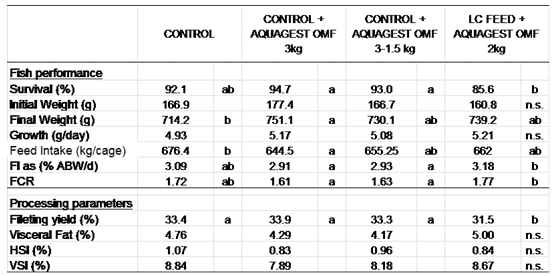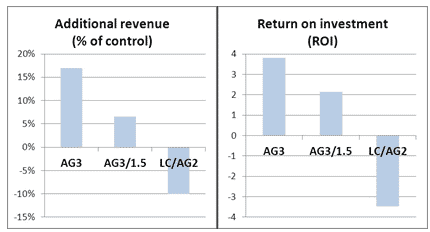The use of feed additives to improve the digestibility of nutrients is an important tool to improve cost-efficiency in intensive production of tilapia.
The current study compares the effect of different application strategies of a digestibility enhancing feed additive on productivity and profitability of tilapia production in cages in Brazil. Reserving a limited budget in the feed formula (often only a fraction of the increase of budget for standard ingredients) for performance enhancing feed additives seems a sound strategy to improve feed cost efficiency, particularly in situations where ingredients prices reach new historic records.
Introduction
Digestibility enhancing additives that are compatible with the digestive physiology of each fish species, have the potential to improve nutrient utilization from cheap ingredients.
Furthermore, they can stimulate the conversion of nutrients into meat gain and reduce the fat accumulation in muscle and viscera. Previous work has revealed the potential of synergistic blends of digestive phytobiotics, natural emulsifying agents and co-factors of digestion to improve feed efficiency and growth, and to reduce visceral depositions in Nile tilapia under lab conditions (Ceulemans et al., 2009).
The optimal application of novel feed additives requires field evaluations to provide information on optimal dosage at different life stages of the fish, and their effects on farm economics and processing qualities of the fish. The optimal application of a digestibility enhancer for pond production of Pangasius in Vietnam resulted in economic gains both for the farmer (up to 2.4% reduction of feed cost per kg of whole fish produced and 16.4% shortening of the production cycle) as well as for the fish processor (up to 7.5 % improvement in filleting yield) (van Halteren et al, 2009).
The present study aimed at the evaluation of different application dosages of a digestibility enhancer as well as the effect of the basal feed quality on the cost efficiency during a production cycle of Nile tilapia farmed in cages in Brazil.
The Cage Trial
The study evaluated the entire production cycle of tilapia, including the processing of commercial size fish, and was carried out by the Instituto de Pesca in collaboration with a commercial tilapia integration in the Sao Paulo region, Brazil. The trial was performed during two consecutive phases in 7 m3 cages: phase 1 (from 28g to approx. 170g) and phase 2 (from 170 g to 750 g, i.e. commercial size).
In Phase 1, 880 juveniles of Nile tilapia (GIFT strain, initial weight 28 g) were stocked per cage. 10 replicate cages were fed the control feed, consisting of a commercial feed (36% crude protein). The treatment feed consisted of the control feed supplemented with a digestibility enhancing feed additive (Aquagest® OMF, Nutriad; 3 kg per MT of feed). The treatment group consisted of 15 replicate cages.
In Phase 2, the stocking density was 800 fish per cage and 4 different treatments were run with 5 replicate cages per treatment: (1) Control: fed a commercial feed with 32% crude protein; (2) AG3: control feed supplemented with the feed additive at 3 kg/MT throughout the entire cycle; (3): AG 3/1.5: control feed supplemented with the feed additive at 3 kg/MT until 350g and subsequently at 1,5 kg/MT until the end of the trial; (4) LC-AG2: low cost feed, formulated with protein of lower digestibility and poorer amino acid profile, supplemented with 2 kg/MT of the feed additive (7% reduced formula cost compared to the control feed).
During Phase 2, the control group was stocked with fish originating from the control group during phase 1; whereas the other treatments were recruited from fish receiving the additive during phase 1.
Feeds were produced in a commercial extrusion line and the additive was included directly in the mixer with all other ingredients prior to extrusion. Feed distribution was based on feeding tables four (Phase 1) and three times per day (Phase 2). At the end of Phase 1, all fish were weighed, average daily weight gain and feed conversion were determined.
At the end of Phase 2, all fish from each experimental cage were weighed and counted. At harvest, 5% of the population per cage were processed for fileting. The evaluated parameters included survival, daily weight gain, feed conversion, filleting yield, viscera weight, liver weight and visceral fat weight.
Results
At the end of Phase 1, fish supplemented with the feed additive showed significant improvements on performance compared to the control group, i.e. 12% better daily weight gain, 5% better survival and 6% better feed conversion (Fig. 1; Table 1).
Table 1: Performance of Nile tilapia (from approx. 170 g to commercial size) fed different diets during phase 1. Averages from 10 and 15 cages for control and treatment group, respectively.
Fig. 1: Daily weight gain and feed conversion of juvenile Nile tilapia during phase 1 (from 28 to approx. 170 g) fed the control diet with or without the supplementation of a digestibility enhancing additive. * indicate significant differences (P<0.05) and deviations from control are shown as percentages in red.
During phase 2, the best results were obtained by supplementing the control feed throughout the production cycle with 3 kg/MT of the feed additive (treatment AG3); resulting in a significantly better final weight and reduced amount of feed consumption at the end of the cycle (Table 2; Fig. 2).
Relatively compared to the control group, treatment AG3 showed improved survival (+2.8%), daily weight gain (+5%), feed conversion (-6.4%), fileting yield (+1.5%), visceral fat deposition (-9.9%), hepatosomatic index (-22%), and viscerosomatic index (-10.7%). Reducing the additive inclusion from 3 to 1.5 kg/MT during phase 2, still resulted in interesting benefits on growth, feed conversion and visceral fat but did not affect fileting yield.
Table 2: Fish performance and processing parameters (fileting yield, visceral fat, hepatosomatic index HSI, viscerosomatic index VSI) of Nile tilapia (from approx. 170 g to commercial size) fed different diets during phase 2. Different letters indicate significant differences (P<0.05).
Fig. 2: Survival, daily weight gain, and feed conversion of Nile tilapia during phase 2 (from approx. 170 g to commercial size) fed different diets (see text for explanation of the treatments). Different letters indicate significant differences (P<0.05) and deviations from control are shown as percentages in red.
The low cost feed performed significantly worse compared to the control feed in most parameters, particularly in terms of survival, feed conversion and fileting yield. The addition of 2 kg/MT of the feed additive was only capable of improving growth but the nutritional impact of reducing the protein digestibility and amino acid balance in this feed heavily affected the overall performance, particularly FCR and survival.
The trials results showed that tilapia are highly sensitive to reducing the quality of the dietary protein in the feed. The digestibility enhancer was not capable of rectifying the effect of inferior nutritional specifications, which finally resulted in a less cost-efficient feed for the producer.
Considering the cost efficiency of the different feeds, the optimal additive treatment (3 kg/MT throughout the production cycle) improved farm revenues with 17% compared to the unsupplemented control group and showed a return on investment (ROI) of 3.8:1 (Fig. 3). Reducing the additive inclusion to 1.5 kg/MT of feed once fish reach 350 g still resulted in 7% improved revenues compared to the unsupplemented control group and a ROI of 2.1:1. The application of the low cost feed supplemented with 2 kg/MT of the additive resulted in important economic losses (10% reduced revenues compared to control).
This study clearly indicated the potential of improving cost efficiency of tilapia feeds through the use of digestibility enhancing additives. The results showed the importance of maintaining the nutritional balance in the feed in order to maximize the benefits of a digestibility enhancing concept. It is important to note that the economic impacts of performance enhancing feed additives (having a relatively stable cost, independent from standard commodity ingredients) increases dramatically with increasing ingredient cost.
Fig. 3: Economic evaluation of different application strategies for a feed additive in tilapia farming. Feed ingredient costs used for this study dated early 2012. Data show change of farm revenues and return of investment, relative to the non-supplemented control group. Treatment groups differ in inclusion of the feed additive and formulation: AG3 (control feed + 3 kg/MT throughout the production cycle), AG3/1.5 (control feed + 3 kg/MT till 350 g; followed by 1.5 kg/MT till harvest), LC/AG2 (low cost feed + 2 kg/MT).
March 2015








